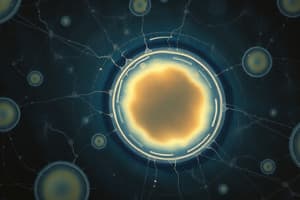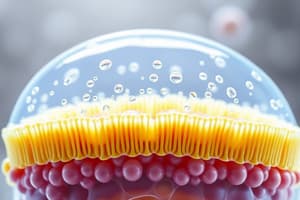Podcast
Questions and Answers
What is the primary function of organelles within a cell?
What is the primary function of organelles within a cell?
- To perform specific functions necessary for cell survival (correct)
- To provide structural support to the cell
- To store genetic material
- To aid in cellular transportation
Which of the following processes is crucial for maintaining homeostasis in a cell?
Which of the following processes is crucial for maintaining homeostasis in a cell?
- Protein synthesis
- Cellular transport mechanisms (correct)
- Cellular replication
- Cellular respiration
Which structure within a cell is responsible for the synthesis of proteins?
Which structure within a cell is responsible for the synthesis of proteins?
- Lysosomes
- Endoplasmic reticulum
- Mitochondria
- Ribosomes (correct)
What role do lysosomes play in cellular function?
What role do lysosomes play in cellular function?
Which component of the cell membrane is primarily responsible for its fluidity?
Which component of the cell membrane is primarily responsible for its fluidity?
Which of the following statements is true regarding the types of cellular transport?
Which of the following statements is true regarding the types of cellular transport?
What distinguishes prokaryotic cells from eukaryotic cells?
What distinguishes prokaryotic cells from eukaryotic cells?
Which structure is mainly responsible for controlling the passage of substances in and out of the cell?
Which structure is mainly responsible for controlling the passage of substances in and out of the cell?
Which process is responsible for the movement of water molecules across a semipermeable membrane?
Which process is responsible for the movement of water molecules across a semipermeable membrane?
What is a primary function of the endoplasmic reticulum in eukaryotic cells?
What is a primary function of the endoplasmic reticulum in eukaryotic cells?
Which structure is responsible for providing energy for cellular processes?
Which structure is responsible for providing energy for cellular processes?
What is the primary role of the cell membrane?
What is the primary role of the cell membrane?
Which of the following best describes the function of ribosomes?
Which of the following best describes the function of ribosomes?
Which organelle is primarily involved in the modification and packaging of proteins?
Which organelle is primarily involved in the modification and packaging of proteins?
What type of transport requires energy to move substances across the cell membrane?
What type of transport requires energy to move substances across the cell membrane?
What function is associated with the structure of the cell wall in plant cells?
What function is associated with the structure of the cell wall in plant cells?
Which statement accurately describes the role of the Golgi apparatus in a cell?
Which statement accurately describes the role of the Golgi apparatus in a cell?
Which process is characterized by the movement of molecules from an area of lower concentration to an area of higher concentration?
Which process is characterized by the movement of molecules from an area of lower concentration to an area of higher concentration?
What is the primary purpose of cellular respiration within the cell?
What is the primary purpose of cellular respiration within the cell?
Which organelle is primarily responsible for detoxifying harmful substances in the cell?
Which organelle is primarily responsible for detoxifying harmful substances in the cell?
Flashcards
Cellular Transport
Cellular Transport
The movement of molecules across a cell membrane.
Cell Membrane
Cell Membrane
The outer covering of a cell that controls what enters and exits.
Passive Transport
Passive Transport
Movement of molecules across a membrane without requiring energy.
Active Transport
Active Transport
Signup and view all the flashcards
Diffusion
Diffusion
Signup and view all the flashcards
What are organelles?
What are organelles?
Signup and view all the flashcards
What is the function of the nucleus?
What is the function of the nucleus?
Signup and view all the flashcards
What is the function of the cytoplasm?
What is the function of the cytoplasm?
Signup and view all the flashcards
What is the function of the cell membrane?
What is the function of the cell membrane?
Signup and view all the flashcards
What is active transport in cell transport?
What is active transport in cell transport?
Signup and view all the flashcards
What is a prokaryotic cell?
What is a prokaryotic cell?
Signup and view all the flashcards
What is a eukaryotic cell?
What is a eukaryotic cell?
Signup and view all the flashcards
What is the endoplasmic reticulum (ER)?
What is the endoplasmic reticulum (ER)?
Signup and view all the flashcards
What is the Golgi apparatus?
What is the Golgi apparatus?
Signup and view all the flashcards
What is the difference between passive transport and active transport?
What is the difference between passive transport and active transport?
Signup and view all the flashcards
Study Notes
The Plasma Membrane
- The plasma membrane is a thin, flexible boundary that separates a cell from its environment
- It maintains homeostasis, the internal balance of a cell
- Important for the survival of prokaryotic and eukaryotic cells
- Allows nutrients to enter and waste/products to leave
- Separates the cell from its surroundings
Selective Permeability
- Selectively permeable membranes allow certain substances to pass while restricting others
- This is crucial for maintaining homeostasis within a cell
Plasma Membrane Structure
- Phospholipid bilayer: Two layers of phospholipids
- Polar heads: Face the water environment (hydrophilic)
- Nonpolar tails: Face inwards, away from water (hydrophobic)
- Lipids (phospholipids, cholesterol, glycolipids): Compose the majority of the membrane
- Cholesterol: Embedded to help maintain fluidity
- Proteins: Embedded in the membrane, some span it (integral), others are peripheral
- Carbohydrates: Attached to proteins (glycoproteins) or lipids (glycolipids) on the outer surface
- The arrangement of these components creates a flexible, fluid mosaic structure, allowing movement
Water Soluble Substances
- Water soluble substances do not easily pass through the plasma membrane
- Substances separate the inner environment of the cell from the outside
Transport Proteins
- Transport proteins move needed substances or waste materials through the plasma membrane
- They contribute to the selectivity of the plasma membrane
- Some are channel proteins (allow passage of specific substances)
- Others are carrier proteins (bind to substances to transport them)
Cholesterol
- Nonpolar cholesterol is positioned among phospholipids
- It helps prevent the fatty acid tails from sticking together, maintaining membrane fluidity
Carbohydrates
- Carbohydrates on the membrane are attached to proteins (glycoproteins) or lipids (glycolipids).
- They play a role in cell recognition and communication.
Fluid Mosaic Model
- The components of the plasma membrane (phospholipids, proteins, carbohydrates) are in constant motion.
- They slide past each other, creating a dynamic structure.
Cytoplasm
- The cytoplasm is the environment inside the plasma membrane
- It is where many cellular activities occur
Transport of Molecules Across the Membrane (Passive Transport)
- Diffusion: Substances move from high to low concentration regions across a membrane
- Osmosis: Water moves from high to low water concentration across a membrane
- Hypotonic Solution: More water outside cell, water moves into the cell to equalize concentration; cell swells
- Hypertonic Solution: More water inside cell, water moves out to equalize concentration; cell shrinks
- Isotonic Solution: Equal water concentrations inside and outside the cell; No net movement, cell shape remains the same.
Active Transport
- Active transport: Movement of substances against a concentration gradient (low to high)
- Energy required: Cellular energy (ATP) needed for this movement
- Examples: Na+/K+ ATPase pump moves Na+ out and K+ in, maintaining ion balance
Transport of Large Particles
- Endocytosis: Cell membrane pinches inward to surround and enclose substances within a vesicle
- Exocytosis: Vesicles fuse with cell membrane, releasing their contents outside the cell (vice versa).
Organelles involved in protein synthesis, secretion
- Ribosomes
- Endoplasmic reticulum
- Golgi apparatus
Studying That Suits You
Use AI to generate personalized quizzes and flashcards to suit your learning preferences.




